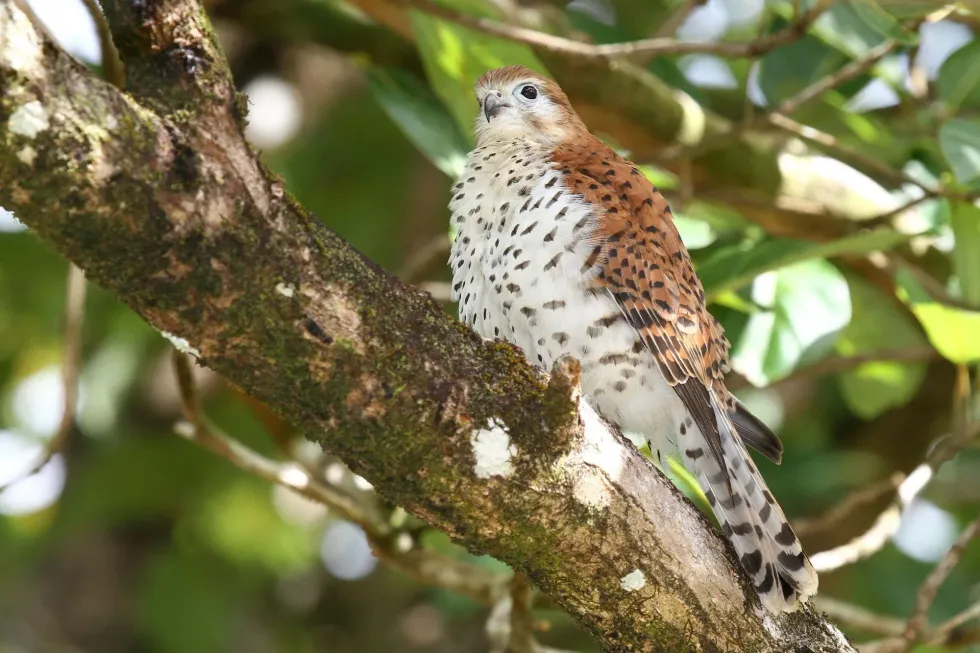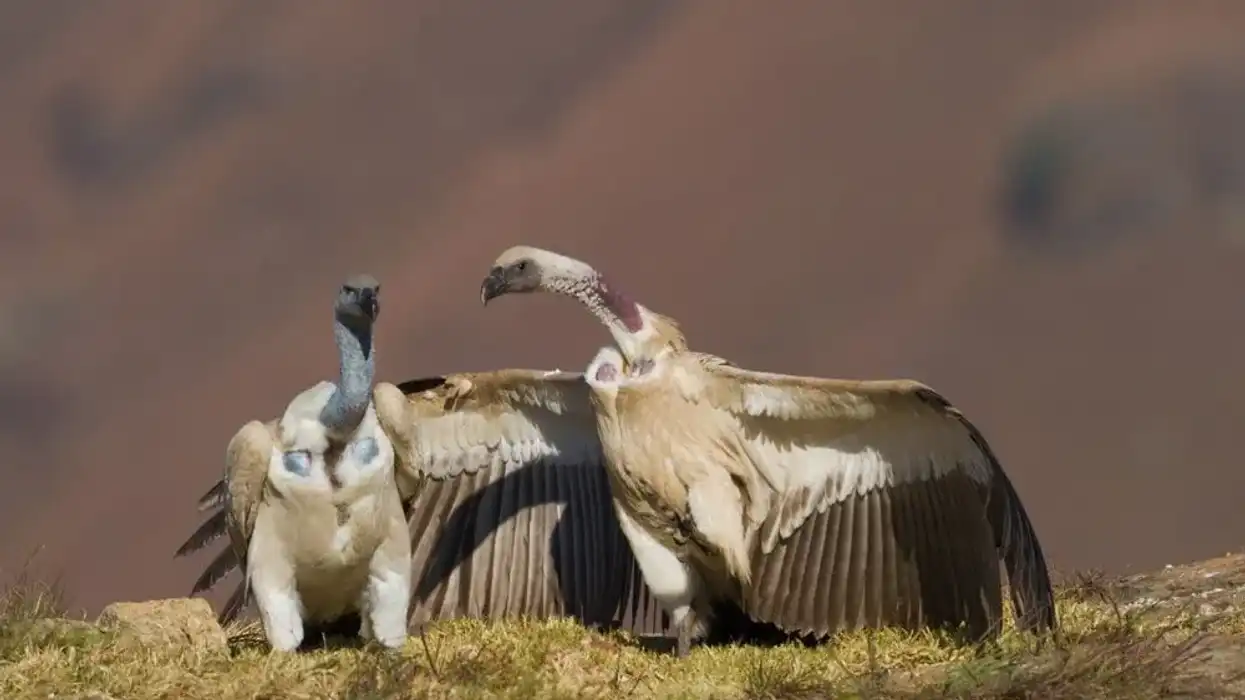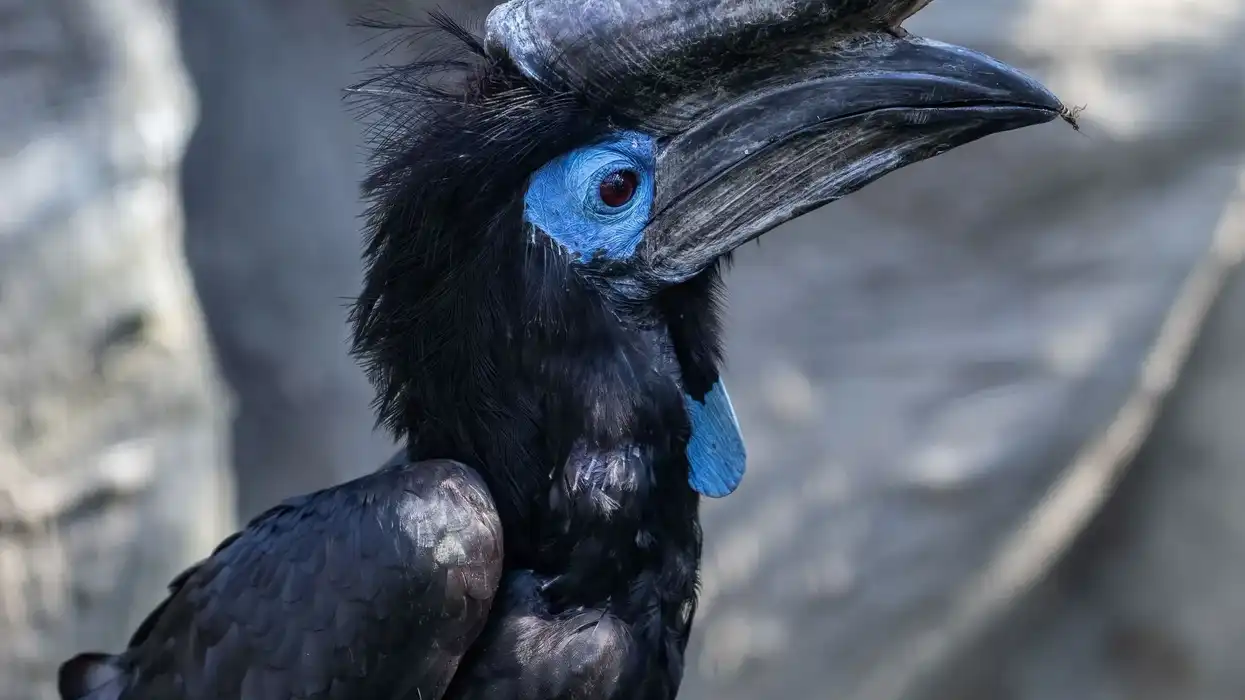The Mauritius kestrel (Falco punctatus) is a small, short-winged bird of prey, that belongs to the Aves class, the Falconidae family, the Falco genus, of the kingdom of Animalia. These vulnerable birds are found on the Mascarene island of Mauritius in the western Indian Ocean, and Madagascar on the east coast of Africa.
The diet of these birds includes Phelsuma geckos, arboreal geckos, small lizards, rodents, insects, dragonflies, shrews, cicadas, cockroaches, crickets, and small birds.
These birds are primarily solitary and like to spend most of their time alone. They are monogamous and their mating season starts in August and lasts to November.
They used to build their own nest in natural cavities, like holes, trees, or rocks, but they recently shifted to artificial nest boxes. This falcon lays two to five white eggs with dark brown markings.
The incubation period lasts for a month.
The young fledgling is born after 35 days of hatching, takes its first flight in less than 40 days, and remains in native forests until the next breeding season. The average life span of a Mauritius kestrel is six years.
It is a small, plump bird with a white face, short wings, covert ears, and chin. The males and females have similar plumage, but the female is a little larger than the male.
The upper body, flight feathers, and long tail are rufous with black bars on the head and mantle. It has dark brown eyes, yellow legs, and a black hooked bill.
The young fledgling has a blue-gray facial skin that becomes yellow during the first year. It is a terrestrial bird and its habitat is predominated by the Mauritian forests, savanna, shrublands, cliffs, ravines, and adjacent scrubby areas. This vulnerable species looks quite cute because of its colorful plumage and small size.
They are the most distinct species of the Indian Ocean kestrels. They communicate by a repeated whining call that sounds like a 'kreech', and a faster chatter that sounds like a sharp 'chip'.
It was once considered one of the rarest bird of prey species while being on the brink of extinction in 1974 due to several threats like the non-timber crops, deforestation, logging, wood harvesting, pesticides, alien species, non-native diseases, agricultural and forestry effluents. Its predators are invasive animals like cats, mongooses, and crab-eating macaques.
These wild birds were saved with the help of a captive breeding program and intensive management of wild birds, initiated by Gerald Durrell, a well-known conservationist.
Several techniques like human-reared kestrels, the release of captive-bred birds, cross-fostering, artificial nesting, and its continued management in the wild were introduced, and their populations have started to increase ever since.
However, their conservation status is still Endangered, according to The International Union for Conservation of Nature (IUCN) Red List of Threatened Species. The estimated population of these birds is 600-800 individuals, and their current population trend is decreasing.
For more relatable content, check out these American kestrel facts and kestrel bird facts for kids.
Mauritius Kestrel Interesting Facts
What type of animal is a Mauritius kestrel?
It is a bird of prey that belongs to the Falconidae family of the Animalia kingdom.
What class of animal does a Mauritius kestrel belong to?
The Mauritius kestrel (Falco punctatus) belongs to the Aves class, the Falco genus, and the Falconiformes order.
How many Mauritius kestrels are there in the world?
Their estimated population is 600-800 individuals. However, their current population trend is decreasing. They were on the brink of extinction in 1974.
Where does a Mauritius kestrel live?
This vulnerable bird is found around the mountainous Black River Gorges, the Mascarene islands of Mauritius in the western Indian Ocean, and Madagascar on the east coast of Africa.
What is a Mauritius kestrel's habitat?
It is a terrestrial bird and its habitat is predominated by the Mauritian forests, savanna, shrublands, cliffs, ravines, and adjacent scrubby areas.
Who does the Mauritius kestrel live with?
The Mauritius kestrel (Falco punctatus) is primarily solitary and likes to spend most of its time alone. This bird can be seen in pairs during the breeding season.
How long does a Mauritius kestrel live?
The average life span of a Mauritius kestrel is six years.
How do they reproduce?
The Mauritius kestrel is monogamous and their mating season starts in August and lasts to November. They used to build their nests in natural cavities, like holes, trees, or rocks, but they recently shifted to artificial nest boxes.
The females lay two to five white eggs with dark brown markings.
The incubation period of the nests lasts for a month. The young fledgling is born after 35 days of hatching, takes its first flight in less than 40 days, and remains in the native territory until the next breeding season.
What is their conservation status?
According to The International Union for Conservation of Nature (IUCN) Red List of Threatened Species, the conservation status of a Mauritius kestrel is Endangered. They were on the brink of extinction in 1974. Their main threats are non-timber crops, deforestation, logging, wood harvesting, pesticides, alien species, non-native diseases, agricultural and forestry effluents.
Mauritius Kestrel Fun Facts
What does the Mauritius kestrel look like?
It is a small, plump bird with a white face, short wings, covert ears, and chin. The males and females have similar plumage, but the female is a little larger than the male.
The upper body, flight feathers, and long tail are rufous with black bars on the head and mantle. It has dark brown eyes, yellow legs, and a black hooked bill. The young fledgling has a blue-gray facial skin that becomes yellow throughout the first year.
How cute are they?
This vulnerable bird species looks quite cute because of its colorful plumage and small size. They are the most distinctive bird species among Indian Ocean kestrels.
How do they communicate?
They communicate by a repeated whining call that sounds like 'kreech' and a faster chatter that sounds like a sharp 'chip'.
How big is a Mauritius kestrel?
Their body length is 7-10 in (17.7-25.5 cm) and their wingspan is 12.01-17.99 in (30.5-45.7 cm). They are almost as tall as the sulfur-crested cockatoo.
How fast can a Mauritius kestrel fly?
Kestrels can fly up to 39 mph (63 kph). However, the flying speed of Mauritius kestrels has not been recorded yet.
How much does a Mauritius kestrel weigh?
The average weight of the male species is 0.27-0.39 lb (123-178 g) and the average weight of the female species is 0.38-0.51 lb (173-231 g).
What are the male and female names of the species?
Male kestrels are known as a tercel, and female kestrels are known as a falcon. However, there is no sex-specific name given to a male and a female Mauritius kestrel.
What would you call a baby Mauritius kestrel?
There is no unique name given to a baby Mauritius kestrel.
What do they eat?
Their diet includes Phelsuma geckos, arboreal geckos, small lizards, rodents, insects, dragonflies, shrews, cicadas, cockroaches, crickets, and small birds. However, their predators are invasive animals like cats, mongooses, and crab-eating macaques.
Are they dangerous?
Although they are a predatory species, Mauritius kestrels do not cause any harm to human beings.
Would they make a good pet?
It is a wild animal that needs its natural habitat to survive. It would not make a good pet.
Did you know...
This bird is sedentary and likes to spend most of its time sitting, but young fledglings perform short-distance movements.
How did a captive breeding programme help to conserve Mauritius kestrels in the wild?
When it was on the brink of extinction, the Mauritius kestrel was saved with the help of a captive breeding programme and intensive management of wild birds, initiated by Gerald Durrell, a well-known conservationist.
Several techniques like human-reared kestrels, the release of captive-bred birds, cross-fostering, artificial nesting, and its continued management in the wild were introduced, and their populations have started to increase ever since.
However, it remains an Endangered species.
Is the kestrel an endemic bird?
The Mauritius kestrel (Falco punctatus) is the only endemic bird of prey alive and it is native to the island of Mauritius.
Here at Kidadl, we have carefully created lots of interesting family-friendly animals facts for everyone to discover! Learn more about some other birds from our bowerbird facts and hummingbird facts pages.
You can even occupy yourself at home by coloring in one of our free printable Mauritius kestrel coloring pages.









